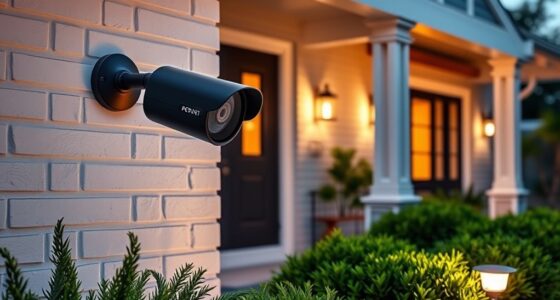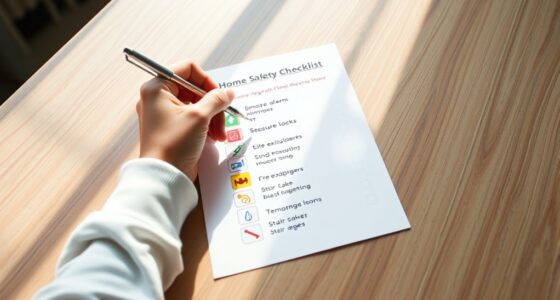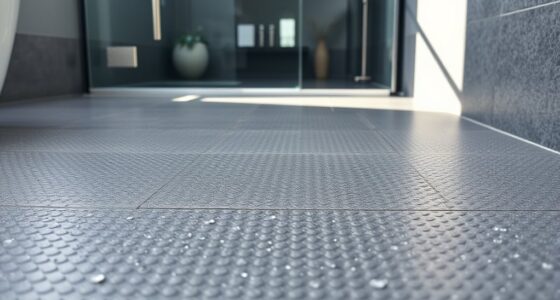To guarantee stair safety, focus on installing stable treads with enough depth, applying non-slip coatings, and regularly inspecting for damage. Use proper lighting that’s bright, even, and controlled with motion sensors or dimmers to improve visibility. Securely attach handrails at the right height with durable materials, regularly tightening fittings and checking stability. Combining these safety measures creates a secure environment. Keep investigating for more tips to help prevent accidents and protect everyone on your stairs.
Key Takeaways
- Ensure stair treads have adequate depth (10-11 inches) and non-slip coatings for stability.
- Install bright, evenly distributed lighting with motion sensors to improve visibility.
- Securely attach handrails at correct height, using durable materials, and conduct regular inspections.
- Use high-quality, compliant materials for treads and handrails to enhance longevity and safety.
- Conduct routine maintenance and safety checks to prevent deterioration and reduce fall risks.
Ensuring Stable and Secure Tread Surfaces

To prevent slips and falls, you need to guarantee that stair treads are stable and secure. Start by checking that the tread depth meets the recommended standards, which typically range between 10 and 11 inches. Proper tread depth provides enough space for your foot, reducing the risk of missteps. Applying non-slip coatings on the surface of each tread adds an extra layer of safety, especially in areas prone to moisture or spills. These coatings increase traction, making it less likely you’ll slip, even if the surface becomes wet. Regularly inspect the treads for damage or wear, and replace or repair them promptly. Ensuring your stairs have secure, well-maintained treads with proper depth and non-slip surfaces creates a safer environment for everyone. Additionally, choosing appropriate materials for your stair surfaces can enhance durability and safety over time.
Optimizing Lighting for Visibility and Safety

Proper lighting plays a vital role in stair safety by enhancing visibility and helping you see each step clearly. To optimize lighting, consider installing motion sensors that automatically turn on lights when you approach, reducing accidents in low-light conditions. Decorative fixtures can add style while providing effective illumination. Bright, even lighting minimizes shadows and highlights each tread’s edge. Use a combination of overhead and wall-mounted fixtures for balanced coverage. Here’s a quick overview:
| Feature | Benefit |
|---|---|
| Motion Sensors | Automatically illuminates stairs, preventing missteps |
| Decorative Fixtures | Enhance aesthetics and provide targeted lighting |
| Bright, Even Lights | Reduce shadows and improve overall visibility |
| Proper Placement | Ensures consistent illumination across all steps |
| Dimmer Switches | Adjust brightness as needed for comfort |
Additionally, selecting appropriate lighting levels can help ensure the stairs are neither too dim nor overly bright, further enhancing safety.
Installing and Maintaining Effective Handrails

Installing and maintaining effective handrails is essential for ensuring stair safety, especially for children, seniors, and anyone with mobility challenges. When selecting materials, choose durable options like wood, metal, or composite that can withstand daily use and environmental factors. Proper material selection not only enhances safety but also guarantees the handrail’s longevity. Always follow local building codes to ensure code compliance, which specifies height, grip size, and secure attachment methods. Regular inspections are vital; tighten loose fittings, repair damaged sections, and clean the handrails to prevent slips. Proper installation involves securely anchoring the handrail to wall studs or brackets to support weight and prevent accidents. Maintaining your handrails ensures they remain reliable, safe, and compliant with safety standards. Incorporating best practices in maintenance helps extend the lifespan and effectiveness of your handrails over time.
Frequently Asked Questions
What Are the Best Materials for Slip-Resistant Stair Treads?
You should choose rubber stair treads or apply non-slip coatings for the best slip-resistant surfaces. Rubber treads provide excellent traction and durability, especially in high-traffic areas. Non-slip coatings are easy to apply and improve grip on existing stairs, making them safer. Both options help prevent slips and falls, so consider your specific needs and environment to select the most suitable material.
How Do I Choose the Right Handrail Height for My Stairs?
You should choose a handrail height that’s ergonomic, comfortable, and compliant with safety standards. Typically, this means positioning the handrail between 34 and 38 inches above the stair nosing. Consider ergonomic handrail designs that fit naturally in your hand and aesthetic railing options that complement your decor. Measure your stairs accurately, account for user needs, and guarantee the handrail provides secure support, enhancing both safety and style.
Are There Specific Lighting Color Temperatures That Improve Stair Safety?
You should choose lighting with a color temperature around 2700K to 3000K for stair safety. Warm white lights enhance stairway aesthetics while reducing harsh shadows, making steps easier to see. Cooler temperatures, like 4000K, create bright, clear lighting but can sometimes cause glare. Opt for a balanced lighting color effect that improves visibility, minimizes eye strain, and complements your stair design for safer, more inviting stairs.
How Often Should Stair Treads and Handrails Be Inspected for Safety?
You should perform monthly inspections of stair treads and handrails to guarantee safety. During these safety audits, look for loose or damaged treads, worn-out handrails, and any signs of deterioration. Regular checks help identify potential hazards early, preventing accidents. Keep detailed records of each inspection, and promptly address any issues you find. Consistent maintenance and vigilance greatly reduce the risk of stair-related injuries.
What Are Common Mistakes to Avoid During Stair Lighting Installation?
When installing stair lighting, avoid common mistakes like lighting errors and installation pitfalls. Don’t overlook proper wiring, which can cause flickering or outages, and ensure lights are evenly spaced for consistent visibility. Avoid placing fixtures too close to the edge or in shadowed spots, as this reduces safety. Remember to use appropriate weatherproof fixtures if outdoors, and double-check connections for secure, safe operation. Proper planning prevents costly mistakes.
Conclusion
By paying attention to tread stability, lighting, and handrails, you create a staircase that’s as safe as a lighthouse guiding ships through fog. When each element works together, you prevent slips, trips, and falls — turning your stairs into a safe pathway rather than a hidden hazard. Keep these safety tips in mind, and you’ll guarantee everyone who uses your stairs feels secure and confident, no matter how dark or busy the journey.









